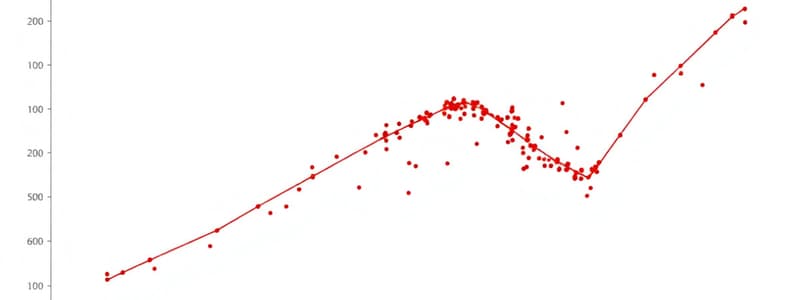Podcast
Questions and Answers
What is the value of the correlation coefficient indicating the relationship between English and Maths marks?
What is the value of the correlation coefficient indicating the relationship between English and Maths marks?
- 0.569
- 0.869
- 0.669 (correct)
- 0.769
Which statistical test can be run if the assumptions for Pearson's correlation are not met?
Which statistical test can be run if the assumptions for Pearson's correlation are not met?
- ANOVA
- Wilcoxon Signed-Rank Test
- Regression Analysis
- Spearman Rho (correct)
What is a requirement for conducting a Chi-squared test related to expected counts?
What is a requirement for conducting a Chi-squared test related to expected counts?
- All cells should have an expected count of at least 1.
- The sample size must be fewer than 30 participants.
- No more than 20% of cells should have an expected count less than 5. (correct)
- No more than 10% of cells should have an expected count less than 5.
Given a p-value of .001 in relation to a hypothesis test, what conclusion can be drawn?
Given a p-value of .001 in relation to a hypothesis test, what conclusion can be drawn?
Which test is appropriate when comparing two groups of participants regarding one interval-ratio variable?
Which test is appropriate when comparing two groups of participants regarding one interval-ratio variable?
What does a p-value of .057 indicate regarding the null hypothesis for syntactic complexity?
What does a p-value of .057 indicate regarding the null hypothesis for syntactic complexity?
Which finding was revealed by the Tukey HSD test regarding the pre-task planning group?
Which finding was revealed by the Tukey HSD test regarding the pre-task planning group?
What is the minimum size of a sample suggested when conducting EFA per item?
What is the minimum size of a sample suggested when conducting EFA per item?
Which statistical test is used to ensure the adequacy of sampling in EFA?
Which statistical test is used to ensure the adequacy of sampling in EFA?
What is the goal of using Multivariate Analysis methods like EFA and PCA?
What is the goal of using Multivariate Analysis methods like EFA and PCA?
What does a Cronbach's alpha value of 0.82 indicate about the reliability of a test?
What does a Cronbach's alpha value of 0.82 indicate about the reliability of a test?
For the means of syllables, what can be concluded about the comparison between the no planning and online planning groups?
For the means of syllables, what can be concluded about the comparison between the no planning and online planning groups?
Which factor extraction criterion must be met for effective EFA?
Which factor extraction criterion must be met for effective EFA?
What hypothesis is represented when stating H1 for the mean scores of syllables across the three planning groups?
What hypothesis is represented when stating H1 for the mean scores of syllables across the three planning groups?
Which factor rotation method is commonly used in EFA?
Which factor rotation method is commonly used in EFA?
What is the mean proficiency score based on the descriptive statistics provided?
What is the mean proficiency score based on the descriptive statistics provided?
What is the standard deviation of the proficiency scores?
What is the standard deviation of the proficiency scores?
Which method can be used to detect outliers in a dataset?
Which method can be used to detect outliers in a dataset?
What does the Pearson correlation coefficient indicate about the relationship between age and proficiency?
What does the Pearson correlation coefficient indicate about the relationship between age and proficiency?
What is the significance level associated with the correlation between age and proficiency?
What is the significance level associated with the correlation between age and proficiency?
What does the coefficient of variation represent in descriptive statistics?
What does the coefficient of variation represent in descriptive statistics?
What is the underlying principle of bivariate analysis using Pearson correlation?
What is the underlying principle of bivariate analysis using Pearson correlation?
Which of the following correctly describes the boxplot's function in data analysis?
Which of the following correctly describes the boxplot's function in data analysis?
What is the significance threshold for accepting a P Value in hypothesis testing?
What is the significance threshold for accepting a P Value in hypothesis testing?
What reflects a perfect positive correlation between two variables?
What reflects a perfect positive correlation between two variables?
Which of the following is NOT an assumption of Pearson's correlation?
Which of the following is NOT an assumption of Pearson's correlation?
What does a Spearman correlation require regarding the relationship between variables?
What does a Spearman correlation require regarding the relationship between variables?
What would happen if the calculated P Value is 0.04 in a hypothesis test?
What would happen if the calculated P Value is 0.04 in a hypothesis test?
What is the relationship strength indicated by r = 0.51?
What is the relationship strength indicated by r = 0.51?
Which of the following is a condition that must be checked for verifying normal distribution?
Which of the following is a condition that must be checked for verifying normal distribution?
When deciding on a statistical test, which factor is NOT relevant?
When deciding on a statistical test, which factor is NOT relevant?
What is the effect size of the difference between early and late exposure learners?
What is the effect size of the difference between early and late exposure learners?
What must the dependent variable meet for a paired samples t-test?
What must the dependent variable meet for a paired samples t-test?
Which of the following indicates a null hypothesis that can be rejected?
Which of the following indicates a null hypothesis that can be rejected?
In a One-Way ANOVA, when would you run Welch's ANOVA?
In a One-Way ANOVA, when would you run Welch's ANOVA?
What is the significance of a Levene P value less than 0.05 in ANOVA?
What is the significance of a Levene P value less than 0.05 in ANOVA?
What is the non-parametric equivalent of the paired samples t-test?
What is the non-parametric equivalent of the paired samples t-test?
What is assumed about the distribution of the dependent variable in the analysis of variance?
What is assumed about the distribution of the dependent variable in the analysis of variance?
What is the effect size indicating a significant large difference between vocabulary scores in pre-test and post-test?
What is the effect size indicating a significant large difference between vocabulary scores in pre-test and post-test?
Flashcards
ANOVA (Analysis of Variance)
ANOVA (Analysis of Variance)
A statistical test used to determine if there is a significant difference between the means of two or more groups.
Null Hypothesis (H0)
Null Hypothesis (H0)
The hypothesis that there is no significant difference between the means of two or more groups.
Alternative Hypothesis (H1)
Alternative Hypothesis (H1)
The hypothesis that there is a significant difference between the means of two or more groups.
p-value
p-value
Signup and view all the flashcards
Tukey HSD Test
Tukey HSD Test
Signup and view all the flashcards
Exploratory Factor Analysis (EFA)
Exploratory Factor Analysis (EFA)
Signup and view all the flashcards
Chi-Square Test
Chi-Square Test
Signup and view all the flashcards
Spearman Rho
Spearman Rho
Signup and view all the flashcards
Multicollinearity
Multicollinearity
Signup and view all the flashcards
Kaiser-Meyer-Olkin (KMO) Test
Kaiser-Meyer-Olkin (KMO) Test
Signup and view all the flashcards
Independent Samples t-test
Independent Samples t-test
Signup and view all the flashcards
Bartlett's Test of Sphericity
Bartlett's Test of Sphericity
Signup and view all the flashcards
Statistical Test Assumptions
Statistical Test Assumptions
Signup and view all the flashcards
Cronbach's Alpha
Cronbach's Alpha
Signup and view all the flashcards
Coefficient of Variation
Coefficient of Variation
Signup and view all the flashcards
Boxplot
Boxplot
Signup and view all the flashcards
Pearson Correlation
Pearson Correlation
Signup and view all the flashcards
Pearson Correlation Coefficient (r)
Pearson Correlation Coefficient (r)
Signup and view all the flashcards
Outliers
Outliers
Signup and view all the flashcards
Standardized Scores (Z-Scores)
Standardized Scores (Z-Scores)
Signup and view all the flashcards
Mean
Mean
Signup and view all the flashcards
Dispersion
Dispersion
Signup and view all the flashcards
Spearman Rank Correlation
Spearman Rank Correlation
Signup and view all the flashcards
Monotonic Relationship
Monotonic Relationship
Signup and view all the flashcards
Scatter Plot
Scatter Plot
Signup and view all the flashcards
Interpreting Correlation
Interpreting Correlation
Signup and view all the flashcards
Paired Samples t-test
Paired Samples t-test
Signup and view all the flashcards
Wilcoxon Signed Rank Test
Wilcoxon Signed Rank Test
Signup and view all the flashcards
One-Way ANOVA (Analysis of Variance)
One-Way ANOVA (Analysis of Variance)
Signup and view all the flashcards
Kruskal-Wallis Test
Kruskal-Wallis Test
Signup and view all the flashcards
Paired Samples T-Test
Paired Samples T-Test
Signup and view all the flashcards
Wilcoxon Signed Rank Test
Wilcoxon Signed Rank Test
Signup and view all the flashcards
One-Way ANOVA (Analysis of Variance)
One-Way ANOVA (Analysis of Variance)
Signup and view all the flashcards
Kruskal-Wallis Test
Kruskal-Wallis Test
Signup and view all the flashcards
Study Notes
Data Analysis - Lecture 3: Preliminary Univariate Statistics
- Describing Nominal Data: Analyze descriptive statistics, frequencies, and missing values. Create charts like bar charts.
- Describing Interval-Ratio Variables: Calculate the mean to describe central tendency. Identify dispersion measures, such as the coefficient of variation (standard deviation/mean * 100).
- Detect Outliers: Create boxplots to visually identify outliers. Use the chart builder to isolate the boxplot. Drag and drop the variable for review.
- Standardized Scores for Outlier Detection: Another numerical method to identify outliers is through standardized scores (z-scores). Items with z-scores between -3 and 3 are not considered outliers.
Data Analysis - Lecture 4: Bivariate Analysis - Pearson Correlation
- Correlation: Variation in one variable corresponds to variation in another variable. A linear relationship between the variables is evaluated.
- Pearson Product Moment Correlation: Measures the strength of a linear relationship between two interval-ratio variables.
- Correlation Strength Interpretation:
- Perfect: 1
- Strong: 0.9-0.7
- Moderate: 0.6-0.4
- Weak: 0.3-0.1
- Zero: 0
- Significance: A p-value lower than .05 indicates a statistically significant correlation.
Data Analysis - Lecture 5: Bivariate Analysis (Spearman and Chi²)
- Choosing the Right Test: Consider the number of variables, the objective (correlate, compare, predict), and the level of measurement (ordinal, nominal, interval-ratio).
- Spearman Correlation: A non-parametric test used when the assumptions for Pearson correlation are not met. It evaluates both variables being at least ordinal, and a monotonic relationship. Check monotonicity with a scatterplot.
Data Analysis - Lecture 6: Bivariate Analysis 3: Comparison Tests (Independent Samples t-test + Mann Whitney U)
- Independent Samples t-test: Used to compare two groups of participants on an interval-ratio variable. Consider Levene's Test for homogeneity of variances.
- Mann-Whitney U test: A non-parametric alternative to the independent samples t-test when homogeneity of variances is not met. Use this test when the assumptions of a t-test are not met.
Data Analysis - Lecture 7: Test Assumptions Across Multiple Analyses
- General Test Assumptions: A summary of sample size requirements, independence of observations, normal distribution, and homogeneity of variance criteria to determine the most appropriate test methodology.
Data Analysis - Lecture 8: Bivariate Analysis (ANOVA + Kruskal Wallis)
- ANOVA (Analysis of Variance): Compares multiple groups (2 or more) on an interval-ratio variable. The test aims to identify if there are statistically significant mean differences between these groups.
Data Analysis - Lecture 9: Multivariate Analysis (EFA+PCA)
- Factor/Component Analysis: Reduce the dimensionality of multiple variables into a smaller number of factors/components for later analysis. The goal of exploratory factor analysis (EFA and PCA is to uncover related items into a smaller pool of variables. This methodology can be utilized to generate a smaller pool of variables to evaluate from a larger pool.
Data Analysis - Lecture 10: Multiple Regression Analysis
- Multiple Regression: Predicts a dependent variable (DV) based on a set of independent variables (IVs).
- Correlation vs. Regression: Correlation measures the relationship between variables. Regression examines the effect of IVs on the DV.
- Interpreting Regression: Assess whether the model adequately explains the variation in the DV. Evaluate the impact of each IV on the DV. The adjusted R-squared (adjusted for the number of IVs) is an insightful measure. The Beta component of each IV can be used to understand the significance each variable plays in the relationship.
Studying That Suits You
Use AI to generate personalized quizzes and flashcards to suit your learning preferences.




